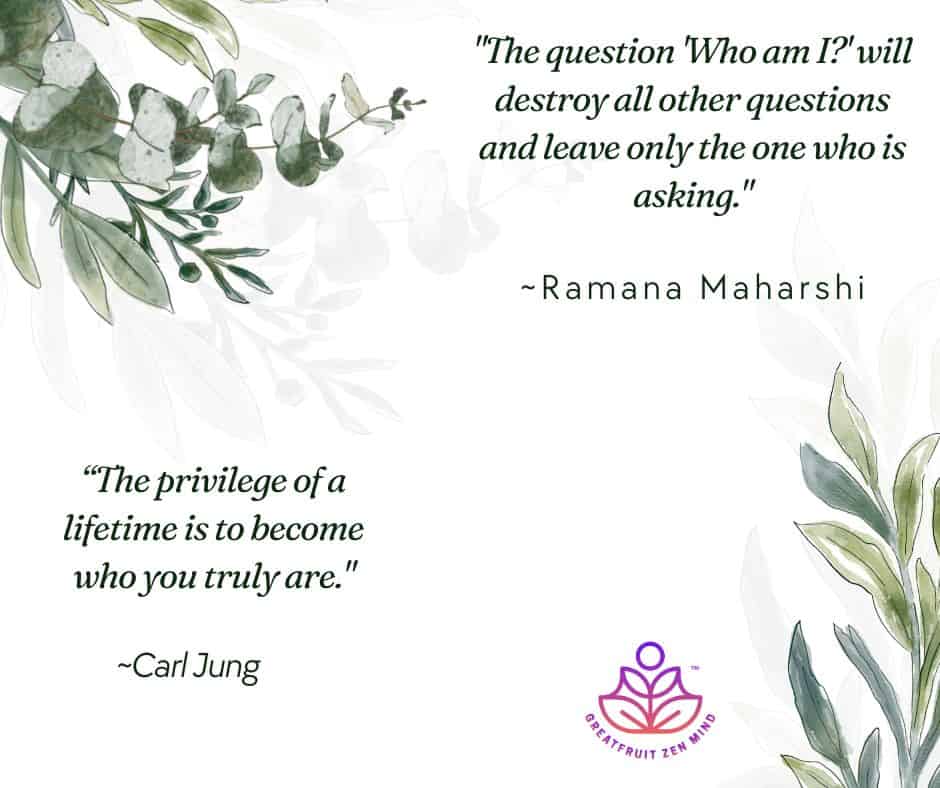Read time 4 minutes. This is a stand alone article in our Who Am I series.
In our recent discussions, we’ve been unpacking the Zen ego in order to better recognize the false sense of self. Now, as we turn toward realizing our true nature, the question naturally arises: Who am I?
Self-inquiry is often presented as one of the most direct paths toward awakening, but it can feel slippery in practice. Today, rather than trying to resolve it all at once, we’ll take a closer look at the heart of this inquiry.
How am I not myself?
I love the film I Heart Huckabees. It’s lighthearted, funny, and full of surprising philosophical depth. In one scene, Lily Tomlin’s character asks Jude Law’s, “What do you think would happen if you didn’t tell the stories? Are you being yourself?” Jude Law responds, “How am I not myself?” Soon everyone is repeating it in a kind of mantra: “How am I not myself? How am I not myself?”
What starts as a harmless question quickly points to something profound. When taken seriously, it sits at the very center of self-inquiry.
We’ve already noted that we are not our thoughts and emotions. To test this, ask yourself: Who is the one that hears the voice in my head? Can I silence those thoughts at will? Do I agree with all of them? The very fact that you can observe your thoughts suggests they cannot be you.
Nisargadatta Maharaj and the question of “I Am”
One of the clearest guides to this inquiry is Sri Nisargadatta Maharaj, whose book I Am That has become a touchstone in modern nondual teaching.
When he urges us to question our I am-ness, he is not asking us to doubt our existence but to examine the nature of the self we habitually identify with. What exactly is this sense of I? Where does it come from? And why does it feel so solid when it is actually so fragile?
He explains: “In the question ‘Who am I?’ the ‘I’ is not known and the question can be worded as, ‘I do not know what I mean by ‘I.’ What you are, you must find out. I can only tell you what you are not.”
In other words, self-inquiry begins by peeling away the layers of false identification.
Who am I and the field of awareness
This inquiry eventually reveals something subtle: awareness itself is not personal. Nisargadatta reminds us, “If you say, ‘I am aware,’ it only means ‘I am conscious of thinking about being aware.’ There is no ‘I am’ in awareness.”
At first, such statements may feel like word salad. But they are part of the practice. Through them, we begin to glimpse that our true self is more akin to awareness itself—a vast, nonlocal field like the Force in Star Wars. It both surrounds us and animates us. It was here before the ego-self arose and remains after it falls away.
The individual I is only a ripple on its surface. Within awareness, all manifestation appears—including the sense of me.
The serious work of self-inquiry
Up to now, we have handled this teaching gently. But to proceed, a sincere and sustained practice is required. Many traditions caution that deep self-inquiry should not be undertaken lightly, and ideally not without guidance from a seasoned teacher.
There is no harm in reading, reflecting, and pondering. But when meditated on earnestly, this inquiry demands nothing less than questioning everything we take for granted about life and self.
If this feels overwhelming, trust your pace and seek guidance when needed. If it inspires, lean into the challenge. Either way, the question remains waiting, quietly insistent: Who am I?
Explore more:
Sri Ramana Maharshi was another well known teacher and proponent of the importance and effectiveness of self-inquiry. This article on Arunachala Ashrama gives a succinct yet complete overview of Sri Ramana Maharshi’s teachings. If you find this topic appealing, I highly recommend taking a look at it. Obtaining fresh takes from many different angles may go a long way toward a genuine understanding of these lessons.
–
Thanks for visiting Greatfruit Zen Mind.
We want to hear from you.
→ Join The Undercurrent.
🌀 From the GZM Archives – Polished, Preserved, Still Relevant


Leave a Reply